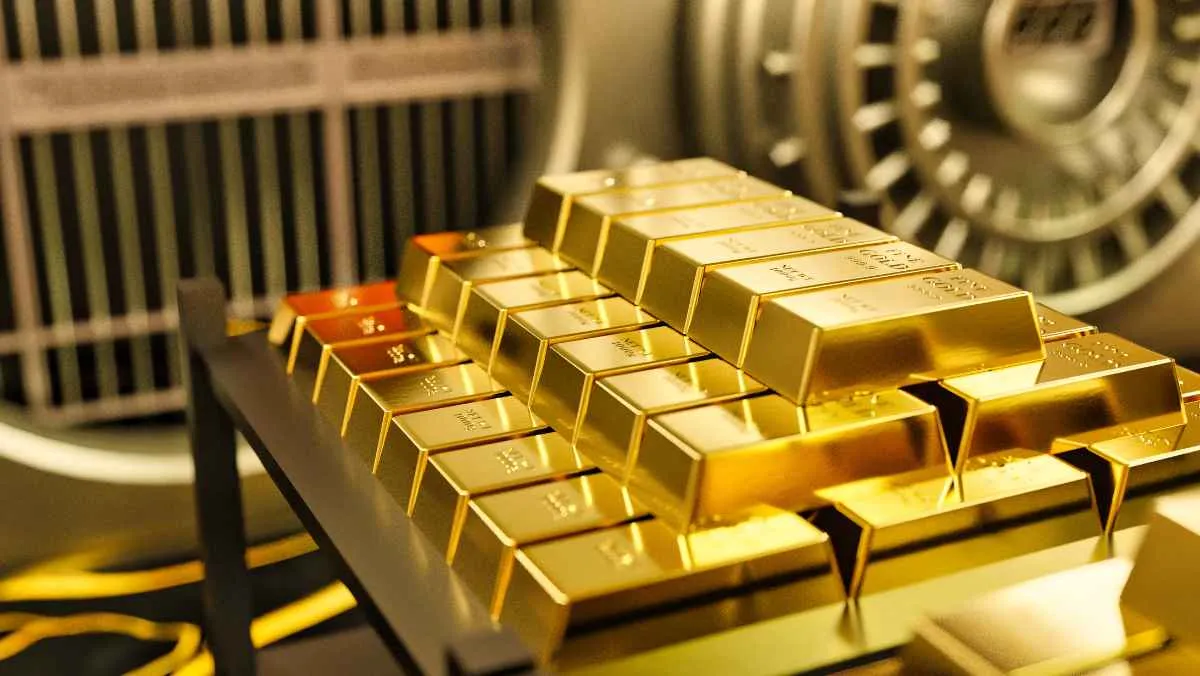Wednesday Dec 6 2023 11:05

9 min

What is gold trading and how do you trade in gold, here is a beginner's guide to navigating the lucrative world of gold markets.
Have you ever wondered how people make money trading gold? Gold trading might sound complicated, but it's pretty straightforward once you understand the basics. As an investor, you buy and sell gold just like any other asset.
The goal is simple: buy low and sell high. If the price of gold goes up and you sell, you make a profit. If it goes down and you buy it, you get gold at a discount.
While physical gold like bars and coins can be traded, most gold trading today is done electronically on the commodities market. That means you don't have to deal with heavy gold bars or worry about securely storing your gold.
You just place buy and sell orders through a broker who handles all the details. To get started trading gold, you just need to open a brokerage account, fund it, and start placing orders. Within minutes you can be trading gold from anywhere with an Internet connection.
Sounds interesting?
Gold trading does take some knowledge, but with a little research, you can learn how to take advantage of the ups and downs in the gold market to potentially profit.
Let's dive in and explore how gold trading works.
1. Physical Gold Trading
Gold Bullion: Buying and selling gold bars or coins. This is the most direct form of gold investment.
Gold Jewelry: Trading in gold jewelry, though this often includes premiums over the gold price due to craftsmanship.
2. Gold Futures
Contracts to buy or sell gold at a predetermined price on a specific future date. Futures trading is typically done on commodities exchanges and allows for speculation on price movements.
3. Gold ETFs (Exchange-Traded Funds)
Funds that track the price of gold and trade on stock exchanges like a stock. Investors can buy shares of the ETF, which represents a certain amount of gold.
4. Gold Mining Stocks
Investing in shares of companies that mine gold. The performance of these stocks is influenced by gold prices as well as the company’s operational efficiency and costs.
5. Gold Options
Options contracts give the holder the right, but not the obligation, to buy or sell gold at a specified price before a certain date. This allows for speculation with limited risk.
6. Gold CFDs (Contracts for Difference)
Derivatives that allow traders to speculate on the price movements of gold without owning the physical asset. Traders profit from the difference between opening and closing prices.
7. Digital Gold
A relatively new method where investors can buy gold in digital form, which is backed by physical gold stored in vaults. This offers convenience without the need for physical storage.
To get into the gold trading game, you'll need to open a brokerage account that allows commodities trading. Many reputable brokers offer access to trade gold, silver, and other precious metals.
So you want to start trading gold? Great! Gold trading can be rewarding, but you’ll need to prepare.
Learn as much as you can about the gold market and what influences gold prices. Things like market sentiment, inflation rates, central bank policies, geopolitical events, and supply and demand can all impact gold. Read books, take a course, and follow expert gold analysts to build up your knowledge.
You’ll need a brokerage account to buy and sell gold. Compare brokers that offer gold trading and choose one with low fees, a simple platform, and strong customer service. Fund your account and you’re ready to get started.
Will you buy physical gold like bars, bullion, or coins? Trade gold futures contracts? Buy shares of gold mining companies or gold ETFs? Each option has pros and cons, so determine which strategy suits your goals.
Begin with a small position to get familiar with the gold trading process. Maybe buy a few gold coins or shares of a gold ETF to start. As you gain experience, you can try more advanced strategies. But always do thorough research before making any trades.
Gold trading does come with risks, but by preparing well, starting small, and paying close attention to the market, you can learn the ropes and work to minimise losses. With time and experience, you’ll get the golden touch!
Read this interesting related article: How do commodity CFD markets work?
So you want to start trading gold, huh? Here are some tips to set you up for success:
Don't risk too much capital when you're first getting started. Open a brokerage account and fund it with an amount you can afford to lose, like $500 to $1,000. Place small trades to get a feel for how the market moves. As you gain experience, you can gradually increase the size of your trades.

Will you be a buy-and-hold investor, buying gold for the long term? Or an active trader, buying and selling frequently based on price changes? Develop a trading plan that matches your goals and risk tolerance. Some options include swing trading, day trading, spread trading or options trading. Each has its own benefits and risks.
Pay attention to factors that impact gold prices several times a day so you can act quickly. Check gold prices, news headlines, and expert analysis on market events. Look for price volatility as an opportunity to buy or sell. When prices start moving rapidly, that's your cue to execute your trading strategy.
With research, practice, and close market monitoring, you'll be trading gold like a pro in no time! But always exercise caution since gold, like any investment, involves risk. By starting small, learning the ropes, and developing a sound trading strategy, you can successfully trade gold for profit.
You might also want to check: How do you go about trading commodities?
Gold trading can seem complex at first, but by starting small, doing your research, and finding a reputable broker, you'll be trading gold in no time.
Remember, gold is a long-term investment, so do your research, buy and hold, and don't panic if the price drops in the short term.
Stay patient and disciplined, and gold trading could provide you with a little extra financial security and even turn into a lucrative investment over time.
Why not dip your toe in the water and place your first trade this week?
Join markets.com now and start trading Gold CFDs!
“When considering “Commodity CFDs” for trading and price predictions, remember that trading CFDs involves a significant degree of risk and could result in capital loss. Past performance is not indicative of any future results. This information is provided for informative purposes only and should not be considered investment advice.”